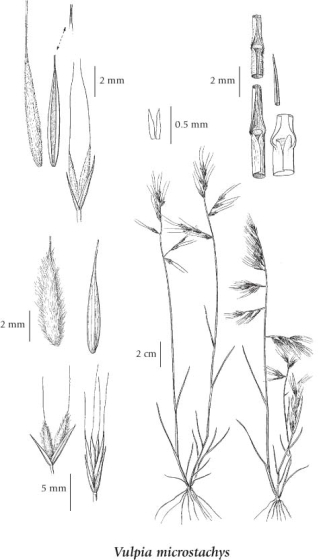Vulpia microstachys (Nutt.) Munro
small fescue
Poaceae (Grass family)
Introduction to Vascular Plants
small fescue
Poaceae (Grass family)
Introduction to Vascular Plants
Species Information click to expand contents
General:
Annual, loosely tufted grass from fibrous roots; stems sometimes solitary, erect (sometimes bent or angled at the lower nodes), (5) 15-35 (40) cm tall.
Leaves:
Sheaths smooth or short-hairy; blades in-rolled or sometimes flat, smooth or short-hairy, to 1 mm wide; ligules 0.2-0.5 (1) mm long.
Flowers:
Inflorescence an open panicle (sometimes reduced to a raceme), the lower branches (and spikelet stalks) spreading or directed backward, (3) 5-11 (14) cm long, the base with callus-like swellings in the axils at maturity; spikelets 4-9 mm long (excluding awns), (1-) 2- to 6- (7-) flowered, the florets loosely overlapping; glumes smooth or short-hairy, the lower glumes 1-nerved, (1.7) 3-6 mm long, the upper glumes 3-nerved, (3.5) 5-8 mm long; lemmas smooth or short-hairy, lanceolate, (3.5) 4.5-7.5 (8) mm long, the terminal awns (3) 6-13 (20) mm long; rachilla internodes about 1 mm long; anthers 1 (rarely 2 or 3), 0.3-3 (3.5) mm long.
Notes:
Several dubious varieties are sometimes recognized based on the presence and distribution of hairs.
Illustration click to expand contents

If more than one illustration is available for a species (e.g., separate illustrations were provided for two subspecies) then links to the separate images will be provided below. Note that individual subspecies or varietal illustrations are not always available.
Illustration Source: The Illustrated Flora of British Columbia
Ecology click to expand contents
Ecological Framework for Vulpia microstachys
The table below shows the species-specific information calculated from
original data (BEC database) provided by the BC Ministry of Forests and Range.
(Updated August, 2013)
The table below shows the species-specific information calculated from
original data (BEC database) provided by the BC Ministry of Forests and Range.
(Updated August, 2013)
| Site Information |
Value / Class |
||
|
Avg |
Min |
Max |
|
| Elevation
(metres) |
640 | 137 | 1280 |
| Slope
Gradient (%) |
29 | 0 | 84 |
|
Aspect (degrees) |
123 | 70 | 315 |
| Soil
Moisture Regime (SMR) [0 - very xeric; 4 - mesic; 8 - hydric] |
3 | 1 | 6 |
| Modal
Nutrient Regime
Class |
D | ||
| #
of field plots species was recorded in: |
11 | ||
| Modal
BEC Zone Class |
CWH | ||
|
All BEC Zones (# of stations/zone) species was recorded in |
BG(2), CDF(1), CWH(3), ICH(1), IDF(2), SBS(1) | ||
|
Source:
Klinkenberg 2013
|
|||
Habitat and Range click to expand contents
Mesic to dry fields, rock slopes, roadsides and waste areas in the lowland and montane zones; frequent in SW BC, rare in SC BC; S to NM, AZ, and CA; South America.
Synonyms click to expand contents
Synonyms and Alternate Names:
Vulpia microstachys var. pauciflora (Scribn. ex Beal) Lonard & Gould